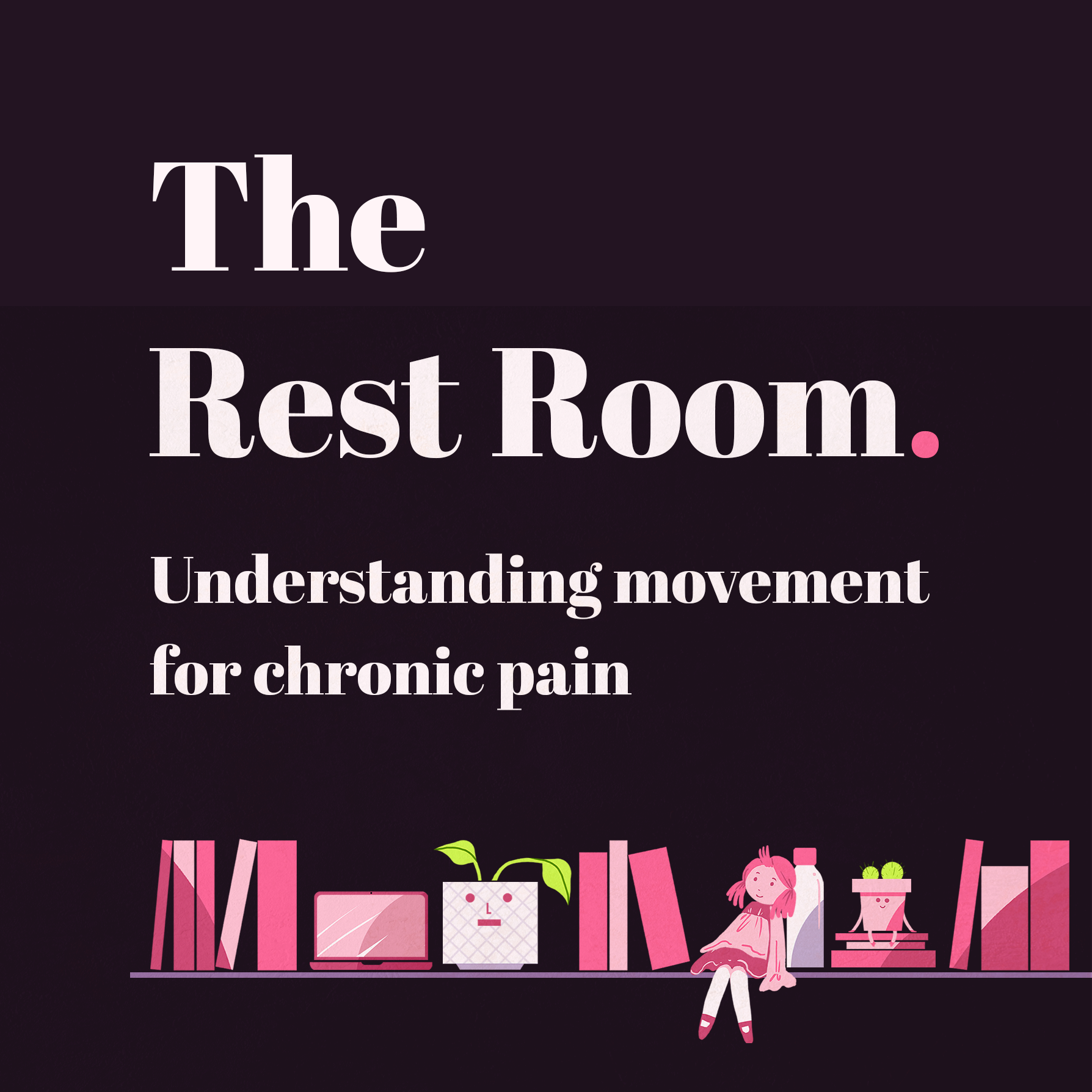You can listen to this blog post as a podcast on Apple Podcasts, Google Podcasts and Spotify.
Hello and welcome to my new series on understanding exercise when living with chronic pain.
I’ve worked with the wonderful Claire Campbell from the Physiotherapy Pain Association to create a series of posts which will hopefully give you an insight into what physiotherapy is, how to reframe how we think about exercise and movement, and some ways to work through both the physical and mental barriers that many people face when it comes to figuring out how to move and get physically stronger in a way that feels safe and sustainable.
Because we have so much information, I’ll be splitting this into more than one post. So if you have any questions before the next ones are published, please do share them in the comments below.
I think it’s worth mentioning, that just like with pacing, it’s important for people to be in a place where they’re ready to hear this kind of information, be able to take it in, and ready to do the work.
When you’ve been struggling with something for a long time (many people have had negative experiences), it can be hard to be open to learning new things and changing your mindset and approach. And sometimes, you’re just not well enough at the time, or have a condition where this is absolutely not recommended, and that’s ok too. The aim of this is absolutely not to push you into something you’re not ready or able to do. It is to provide information to people who could potentially make use of it.
Thinking about movement and exercise can be particularly challenging when you don’t have access to the adequate care that you need. It is our hope that with these posts, you will be able to learn the latest evidence-based introductory information that will help you be able to take some of those first steps by yourself in a safe and sustainable way, and help you to become a more informed and active participant in your care.
I hope you find this helpful, and I’m extremely grateful to Claire for taking the time to provide the information used throughout this series.
Today, is a bit of a ‘primer’ post, so it won’t go into too much practical stuff just yet. We’ll be looking at:
- Understanding what physiotherapy is
- The role movement can play in pain management
- Why it’s important the psychological component of movement and pain isn’t ignored
- The expectations that we have of both physiotherapists and ourselves
Ok, so let’s start with the basics, shall we?
What role can exercise play for people who experience pain?
It’s well known that exercise is important for health and well-being. Exercise can support people to maintain symptoms at a steady level and allow them to have the capacity to do things that are important in their daily life.
You may believe that due to the extent of your condition or disability that exercise is no longer safe for you. Again, if you are one of these people, then the advice here is not for you. However, there are very few conditions where exercise is not indicated. Often, it is about getting the dose right.
It may be that the right dose of exercise to get started with might be much lower than you think is worthwhile. It is notable that small increases in daily activity have the most benefit for those that are most inactive – which is good news for those that feel unable to commit to an ‘exercise programme’ at the moment.
Expectations can be a significant barrier when thinking about movement and exercise.
It’s worth thinking about:
- What do you consider to be exercise?
- What about physical activity?
- What is movement?
- Have you been told that movement is safe for your condition?
- Are there some movements or activities that hurt just thinking about them?
People with long-term conditions can have beliefs about exercise that are no longer helpful for their health and wellbeing.
Stopping certain activities that have caused pain in the past may have been helpful in the short-term, but often this can lead to other problems. It may be that you believe exercise needs to hurt, or you need to be breathless for it to be effective.
In the initial stages (depending on your current level of daily activity), you may feel that the exercise you are doing “doesn’t count” or is not effective. The key is finding a level of activity that you can practice consistently.
Moving your body is a good thing, but you should feel safe doing it.
Inactivity has an impact on our mental and physical health. The less active you are right now, the more benefit you can get out of small amounts of activity.
Breaking up periods of inactivity every 30 -60 min with “movement snacks” can do you good. This can be as simple as standing up, swaying to music, or taking a walk around the room.
Unfortunately, as counter-intuitive as it may seem, prolonged rest can result in more pain and fatigue.
In the next post we will discuss an approach to getting more active that takes into account where you are now, what you might experience when you start, and clarifying your motivation for engaging in movement.
But first, we just wanted to share a bit of information about physiotherapy.
What is Physiotherapy?
Physiotherapists are professionals that work with people to improve their health and wellbeing.
They do this by helping people to find their motivation and solutions to improve their movement. Like any healthcare profession, individual physiotherapists will differ in their approach due to their interests and experience.
Claire is a chartered physiotherapist who has specialised in pain management. She works for an NHS pain management service, supporting people with a wide variety of conditions, but what they all have in common is that they are trying to live as best they can with really difficult symptoms.
She uses a variety of approaches to personalise the rehabilitation she offers, with the aim of supporting people to live well with pain. Pain management is complex, but movement strategies are often a cornerstone of people improving their quality of life.
There are currently no treatments that consistently reduce pain for the majority of people who experience persistent pain.
As a result, many healthcare professionals report reduced confidence in supporting people with persistent pain.
“I experienced imposter syndrome writing this,” Claire explains. “Although I have been a physiotherapist for 10 years, I have had hypermobility and recurrent pain for much longer. For the majority of that time, I have struggled to exercise in a way that is helpful for me. This has inevitably informed my approach to exercise when I am supporting people who experience persistent pain.
I am passionate about the ways physiotherapists can help people who experience persistent pain, but I am even more enthusiastic about the things people with pain do for themselves to improve their lives. You are the only person that can change your habits, and that could change your life for the better.”
Many physiotherapists seek additional training to improve their ability to help people with complex pain.
Claire joined the Physiotherapy Pain Association to avail of the resources the network offers and to connect with like minded others in the profession. This has helped her gain a deeper understanding of the complex nature of pain, and to develop skills to support people to manage their pain, including psychological skills.
Not because pain is psychological, but because the impact of pain can infiltrate every aspect of a person’s life.
An approach that takes this into consideration, recognises past experiences that people are bringing into their sessions with them, as well as understanding their current needs, and aims overall to offer a more compassionate and helpful approach to patients.
What are reasonable expectations from physiotherapy?
Depending on your goals when seeking healthcare, a physiotherapist can be well placed to support you to improve your understanding of your condition and how it is affecting you.
For example, connective tissue disorders and PoTS are spectrum disorders, which means that it will affect everyone slightly differently. You know your body better than anyone will, but it may be helpful to discuss your difficulties with a physiotherapist to figure out together what could be a changeable part of your condition or how you could manage your condition in a better way.
Sometimes people cope with their condition in a certain situation that is no longer workable when they find themselves in another situation, and this can result in unintended problems.
Physiotherapists can offer support and encouragement to people who don’t feel confident doing certain activities. They can find ways to explore different activity options that may be possible.
If you have goals that you want to achieve, physiotherapists are very experienced in supporting people to develop a plan to reach these.
They can help you to look at the aspects involved in certain activities and guide you on a training plan to enable you to engage in these activities.
Tina is someone who lives with neuropathic pain and has written about getting the most out of physiotherapy in a blog and leaflet. She is also involved in the Physiotherapy Pain Association as a Patient Representative on the committee and has been a huge support in ensuring patients are the focus of all the network’s activities.
Physiotherapists can also offer techniques or strategies to maintain your pain symptoms at a manageable level. This may be as simple as further information on heat or cold packs, guidance on how to implement activity management (or pacing) strategies, or other approaches. Physiotherapists deliver rehabilitation to individuals, but also within groups.
Group rehabilitation can be helpful for many, as people benefit from connecting as much with others who experience similar struggles as they do with health professionals, obviously, with the COVID 19 pandemic, the opportunities for group rehabilitation will be affected.
Physiotherapists can do additional training in a range of techniques, just ensure that you weigh up the value of each component in your rehabilitation and have the opportunity to decline a certain aspect if you do not feel it is worthwhile.
Physiotherapy is a profession, not a treatment, so even if you have had a mixed experience with a physiotherapist before, you may gain benefit from another assessment. Or you may build on the hard work you have done previously with a slightly different focus.
Connective tissue disorders and PoTS are under researched conditions and as professionals, we are always learning about the best available evidence for patients that seek our care.



1 thought on “Introduction: Understanding Movement For Chronic Pain”
Such an excellent blog and introduction to physiotherapists who work with people with pain. Thank you Natasha, Claire and Tina